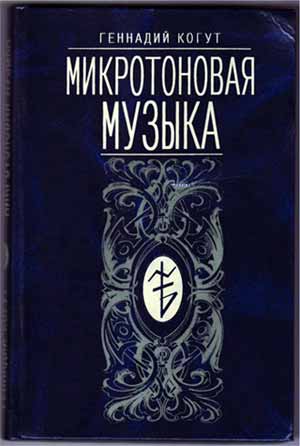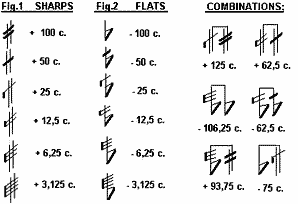



May 30, 2008

This week I was very pleased to receive this beautiful book in my mailbox, sent to me most generously by its author Gennadiy Kogut (b. 1944), musicologist from Ukraine, who has labored for 45 years in the field of microtonality, the majority of that time working behind the Iron Curtain, in total isolation from all resources in the field outside of the former U.S.S.R., virtually forced (in his words) "to reinvent the bicycle", attacking the fundamental problems of tuning in terms of theory, notation, instruments, composition and performance. Anyone who has undertaken these tasks knows of the tremendously great difficulties involved, and I can only imagine these difficulties compounded with a completely cloistered research environment. It is therefore with great respect and admiration for Mr. Kogut and his work that I now write this. There are also some remarkable parallels between Kogut's work and my own, and although we have never met, I feel a kindred spirit and I hope one day we might meet.
I first became aware of Kogut's work in April of 2001, when I attended the Microfest in Los Angeles, which also featured the presence of composer Lou Harrison (1917 - 2003), and celebrated the centennial of the birth of Harry Partch. The conference was a fantastically exciting experience — an intense mixture of lectures and performances. Of the many memorable presentations, two were given by the brilliant and controversial Brian McLaren. One of McLaren's lectures focused on the work of Alexei Ogolevets, about whom I have just added a new page to the microtonal history section of the H-Pi website, at the suggestion of G. Kogut. Those in attendance at this particular lecture may recall that McLaren's presentation on Ogolevets took an unexpected (or possibly quite expected?) turn, transforming into a polemical diatribe against strict adherence to theories of Just Intonation ("the lecture that was banned and supressed … etc."), but I digress! I mention this lecture, simply because there is an important connection between Alexei Ogolevets and Gennadiy Kogut. During the years just prior to his death, Ogolevets was Kogut's mentor, and Kogut has since carried forth some of Ogolevets's ideas as part of his own original work. Kogut's work was the focus of the second of McLaren's lectures. This second lecture was a straightforward presentation of one of Kogut's papers, translated by McLaren from the original Russian, with the assistance of the author. McLaren's English translation of this paper appears in Kogut's book on pages 214 - 221. Additional excerpted works with some English text are included in the book, by David Finnamore, Kyle Gann, Erv Wilson, Joe Monzo, and Manuel Op de Coul, although these are not articles but useful tables, charts, and lists. The first 167 pages of the book are written entirely in Russian.
The author described the book to me by email, as follows:
"This book is written to acquaint especially musicians of the countries of the East Europe with the basic achievements and directions of development microtonal music all over the world, since this information in our countries (it: Russia, Ukraine, Belarus and all other republics of the former USSR), and also Poland, Hungary, Czechia, Slovakia, the country of Baltic etc. - practically is not present.
Therefore the book will consist of the author's foreword, the introduction in which in particular there is a definition of the term microtonal music is the music using as the basic means of expressiveness intervals of less than 90 cents in diatonic structures (all 'old' diatonic structures before introduction 12-ET contained diatonic semitones in size of 90 cents), and it is less than 100 cents in other structures. The following section book (page 22) results examples of how the acoustic realities surrounding us, our thinking influence formation of those or others microtone structures. Here examples of known composers and the musicians offered those or other structures both with the countries of the West, and in the countries of the East Europe are resulted. At the end of this unit classification of structures on their characteristic properties is resulted.
On page 95 the section is devoted to problems notation microtonal music and my additional signs allowing notation up to 200 tones in an octave without especial complication of system of musical record are offered. (Today I have a little simplified this system notation and if it will be interesting to you, I can send she to you is one figure on half-pages).

[NOTE: image above is Kogut's latest simplified notation (sent to me by email) which is not in the book. Updated June 2, 2008. A future H-Pi web page is planned which will include this image in a gallery of various notation systems used by microtonal composers]
On page 118 the section in which I have tried begins to reflect features of construction universal microtonal keyboards, and also keyboards with flexible, elastic melodic structure.
On page 130 the section with my examples of the analysis microtonal pieces of music - from folklore samples and fragments from professional compositions - up to H.Lahenmana's small play begins.
Page 161 - the conclusion.
Further appendices follow:
It followed with the list of the literature." — Gennadiy Kogut
Although I did once take a summer course in the Russian language at age 17, I learned very little and now (at more than twice that age) I have only phonetic abilities with the Cyrillic alphabet, which I had to relearn before my first trip to Bulgaria in 2005. So my understanding of the text remains far from clinical, yet I will treasure this book, as each page speaks to me very clearly with a message of tenacity and burning inspiration. Thank you, Gennadiy!
[ Showing 1 entry | Next entry | Show all entries ]